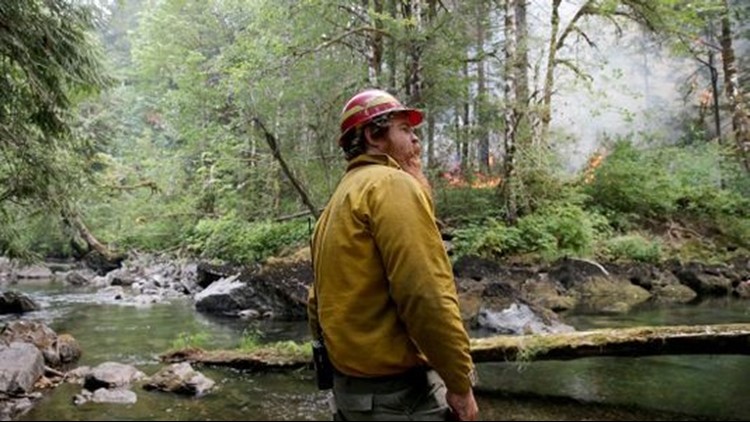The fire burned in a ragged line along the bank of the Hamma Hamma River, fanned on by a persistent breeze.
Orange flames crackled through the underbrush, occasionally licking up the trunks of mossy trees that arched above the stream.
U.S. Forest Service firefighter Ben Dean watched the fire's methodical progress with admiration.
"It's really pretty moving across that landscape," Dean said. "As far as resource benefits go, this is doing very well for the forest."
The flames backing down to the river Wednesday marked the northeast edge of the Maple Fire, a 1,600-acre wildfire burning on the east edge of Olympic National Forest. Hundreds of responders from a multitude of agencies spent the last two weeks working to box in the blaze, which investigators believe was caused by a human on Aug. 4 (the circumstances remain under investigation).
Though costly to contain, the fire isn't necessarily bad for the health of the forest. Flames have burned in a mosaic pattern along the flanks of Jefferson Ridge west of Highway 101, scorching trunks but leaving most mature trees intact.
"For the most part, most of these trees will survive," Forest Service public information officer Jacob Welch said. "It's a low-intensity, understory burn for the majority of this fire."
The fire has threatened few structures, and though roads and trails are closed in the area, no homes have been evacuated.
Pausing on the bank of the Hamma Hamma on Wednesday, Dean was already envisioning a rejuvenated woodland.
"It's going to clear out those snags from the hillside, open up canopy for new cedars and Doug firs to start growing in there. In two years, Roosevelt elks will probably move back in here to graze," Dean said. "Fire's not the evil it was when we all grew up."
A small fire gets big
Dean was among the first responders to confront the Maple Fire, joining a Forest Service team dispatched to a report of smoke in the area on the morning of Aug. 4. The Forest Service crew linked up with volunteer firefighters from Mason County and hiked in to find the source of the plume.
The fire was small when they arrived — about 30 feet in diameter — but was burning through a deep layer of duff around the trunks of two old growth trees, making it tough to snuff out. More worrisome, flames were climbing a 90-foot-tall bigleaf maple.
The crew drenched the ground fire with water from portable bladders and requested a tree faller to take down the maple, but none were available, Dean said. Instead, the firefighters hiked out to retrieve a pump they could use to douse the tree. By the time they returned the towering tree had tossed embers into the surrounding forest, spreading the fire to 3 acres.
From then on, the Maple Fire grew in bounds, aided by high temperatures and low humidity. Rugged terrain made the scene difficult to reach. Trees with charred roots tumbled down the sheer slopes, adding to the danger.
"This chunk of ground in particular, there's no access to it," Dean said. "It's super steep."
Containing the blaze
Over the past two weeks, firefighters built containment lines to hem in the fire's south, east and north edges, protecting man-made infrastructure and state-owned timberland. Creeks form natural barriers in places. The west edge, facing Jefferson Ridge and a wild swath of National Forest, is too difficult to contain and will instead be monitored.
Teams from the Forest Service, state Department of Natural Resources, private firms and fire departments responding from several states were busy at the scene Wednesday. Some cleared brush along road shoulders or refilled portable water tanks that fed sprinkler systems soaking the foliage. Mop-up crews dug out smoldering material in patches of scorched forest.
Smoke mingled with dust along a Forest Service road on the south edge of the fire, where a dozen workers from P.R. Reforestation fed downed branches into a chipper. The Salem, Oregon-based outfit has already worked fires for more than three weeks this summer, "and the season has barely started," employee Jesus Ramirez remarked.
Maple Fire's growth slowed to a crawl after a brief rain last weekend. Plumes of smoke, indicating pockets of intense burning, became more scarce. With redundant fire lines established on three sides, Welsh said firefighters will gradually be reassigned to the many other fires raging across the country.
More humid nights hamper and eventually extinguish the Maple Fire, but logs and stumps could smolder for weeks.
"It will definitely be around for a while," Dean said.



